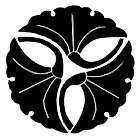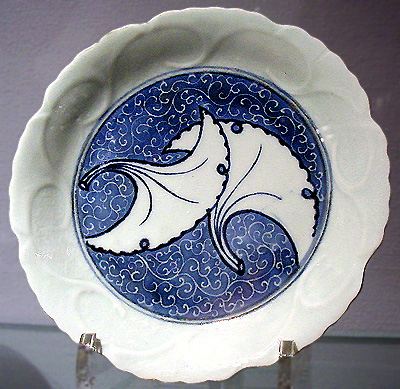|
 Art
& Design Art
& Design |
Page 1 of 2

| .. |
.
|
|
| . |
 Bronze
instrument with end bells. Bronze
instrument with end bells.
From excavation site no. 22, tomb at Bokcheon-dong tumulus group in Busan, South Korea. Size: 11.3cm long. Material: bronze. The instrument consists of a long stick with a round ring at the end, seven Ginkgo-shape bells are attached on the ring. Each bell has four holes and a small bead inside. Sound is made by shaking the bells . A piece of wooden stick is attached to the instrument and it is assumed that the instrument was inserted on top of a long wooden stick. The instrument is believed to have been used as a symbol of social status or in burial ceremonies. Bokcheon Museum: history of Busan from the prehistoric age to the Three Kingdoms Era (57 BC to AD 668). |
. |
| . |
| . | 
In
China the Ginkgo is depicted on a silk painting by GuKaiZhi (345-400 AD)
of the poem "LuoShenFu" and on 'The Seven Worthies of the Bamboo
Grove and Rong Qiqi', relief-murals on bricks of the walls of (royal) tombs
of the late 4th - early 5th century AD and of the late 5th century AD (picture
below and many more here). More pictures in my
gallery.
In the oldest classic Chinese literature the Ginkgo is not mentioned, but
in the 11th century (Sung dynasty) it appeared in literature as a plant
native to eastern China.
From that time on the Ginkgo is depicted on Chinese paintings and appeared in poetry. Many famous poets praised its ‘fruits’ and sometimes also its leaves. Especially the poets Ou-Yang Xiu and Mei Yao-ch’en, who had both official positions in the capital Kaifeng, exchanged verses about the Ginkgo. The seed is often compared with the walnut by Sung-poets which was a popular fruit of the north. In
Hsuan Ho Hua P’u, Catalogue of Paintings of the Imperial Collection of
the reign of Emperor Huei Tsung (reign 1101-1125) several paintings of
the Ginkgo are listed. One is titled “A picture of Yin Hsing (Silver Apricot)
and the bird Pei Tou Wen” made by an artist called Yo Shih-hsuan, an official
of the reign of Emperor Shen Tsung (1067-1084). Another entry lists two
paintings of “A study of Ya Chio (Duck’s Foot)” by Prince Tuan Hsien Wang,
4th son of the Emperor Yin Tsung (reign 1063-1066) and brother of Emperor
Shen Tsung.
Part of relief-mural
of 'The Seven Worthies of the Bamboo Grove and Rong Qiqi'
The
first description of the Ginkgo found in Japanese literature is of 1530
when the poet Socho wrote in his travel diary (1530) that he had gathered
yellow Ginkgo leaves and gave them to someone together with a waka.
Many legends are written in Chinese and Japanese relating to the Ginkgo. In Japan the Ginkgo is often used in haiku-poems and is then called 'icho-ba(ne)' meaning Ginkgo-feather.
Ofuji, nickname 'Miss Ginkgo'
(Icho Musume), on woodblock print
From
about the 17th till 19th century the Ginkgo appeared as a motif on swords,
handmirrors, ceramics, tsubas.
A
watercolour of a Ginkgo branch wearing seeds (1767) by a Chinese artist
working for John Bradby Blake in Canton, China, is probably the first
Western documentation of Ginkgo from its native China, in the 1850s followed
by a watercolour by a Chinese artist working for Robert Fortune showing
a mature Ginkgo with a small human figure.
From
the 19th century on the Ginkgo motif is also found on brooches, buckles,
(hair)pins, necklaces. In Japan on ceramics (plates, vases etc.), paintings,
woodcarving, kimonos, , lacquerware, textile and prints. In 1815 Johann
Wolfgang von Goethe wrote his famous poem about the Ginkgo.
Adonis plant
and two fans
|
. |

Stone tablet, Xian, China - Confucius and the Ginkgo .
Tanka by Yosano
Akiko
Signature: Bushu Jyu Masayoshi length: 7.99cm, width: 7.94cm Middle Edo period
More
pictures in
|
. | ||
| . | . | . |

Ou-Yang Xiu (1007-1072 A.D.) wrote in a poem to Mei: (summary from Chinese) "Human
nature changes in time. Someone should record the beginning so that future
generations can know its (= the Ginkgo) origin. This is thus not only continuing
your verse, but also contributing to history".
|
. |
| . |
| . | 
FAMILY
CRESTS
In
Japan family crests with a Ginkgo-leaf design have been used since the
Middle Ages. Family crests appear on roof tiles, gates, walls of castles,
temples, shrines, mansions or are engraved on gravestones and swordguards.
They are also dyed or woven in flags and ceremonial kimonos and so on.
The
leaves are used in more than 100 patterns, classified by the number of
leaves (1 to 16) and also by the arrangement of the leaves. Many make a
circle or are encircled, some in a square shape, diamond, pentagon, hexagon,
etc. Some are combined with other plants or are shaped like a butterfly
or crane.
|
. |

.
|
. |
| . | . | . |
.
.
|
.
| . |
| TEXTILE
- FUKIYOSE
enlarge picture   |
. |
| The Ginkgo is further shown on a picture of a flower vase called icho-guchi (Ginkgo mouth vase) depicted in “Okazari no sho” (1523). This icho-guchi is also mentioned by Matsuya in 1613 used during a tea ceremony. | In
1655 two incense cases with a Ginkgo leaf on the lids were made at Nin’naji
Temple in Kyoto.
Also in the Momoyama and Edo periods lacquered works were made. |
|
|
|
. |

Plates
with Ginkgo leaves
Nature was an important source of inspiration. |
| . | . |
.

Tokyo city and metro symbol
|

Logos -symbols The Nakamura family of the Kabuki theater had a logo that used a Ginkgo leaf shaped into a crane and put it on a flag. This is mentioned in Nisemonogatari Tsuhosho (1785). It is pictured on a print Nakamura-za Shibai-zu by Okumura Masanobu in 1731 and the logo can also be seen three times on the print left (part of Nakamuraza Naigai no Zu by Utagawa Toyokuni, 1817). Today
many towns, cities, prefectures, incl. Tokyo, use the Ginkgo leaf logo
on printed materials etc. and universities and high schools use the logo
on badges, stationery etc.
|
. |
.
| . |
| . | 
ART
NOUVEAU - JUGENDSTIL - ART DECO
At the end of the 19th century artists of the Art Nouveau movement (New Art, Jugendstil, Secession) in France, Germany, Bohemen, Belgium and other countries started using among others the Ginkgo motif (branches, leaves and seeds) for their works of art. Nancy
was the centre of this movement in France inspired particularly by Japonisme.
The Ecole de Nancy's interpretation of Art Nouveau consisted of nature
depicted with fierce realism, whereas elsewhere it was more abstract
and refined or absent.
stained-glass
window painted by Jacques Gruber with Ginkgo leaves and seeds, 1910
Click
here for my special page about Art Nouveau and Ginkgo in the
l’Ecole de Nancy.
In France (Nancy and Paris) the Ginkgo motif in this style was used on ceramics and glass (Gallé, Gruber, Daum), in architecture, on wrought iron work, for instance lamp foots (Majorelle, Brandt), on ornaments made of gold and silver and other material (combs, brooches, buckles, necklaces, (hair)pins and so on), on furniture (Majorelle) and on silver-plated metal objects. Branches with leaves and seeds were used in public and private buildings, on building facades, balconies, door and window posts. Jugendstil
in Germany was more stylised than Art Nouveau. Examples are metal objects,
for instance Friedrich Adler (designer) and Theodor von Gosen (sculptor,
gold- and silversmith), and prints in books and magazines.
Ginkgo branches, leaves and seeds on facade of Hotel Central in Prague, 1898-1900
Click
here for my special page about Art Nouveau and Ginkgo in Prague.
In Vienna ornaments in the new style were made among which a very expensive necklace and earrings made of gold, platinum and diamonds with Ginkgo leaves and seeds design by Roset & Fischmeister (c. 1900). The
Ginkgo motif is also used in the later Art Deco period.
|
. |

BNP, Majorelle, 1910 .enlarge picture
|
. |
| . | . | . |
More art & design on the second part of my Art-page.
|
please send me an email: |
![]()
© Cor Kwant ![]()
Copyright information.